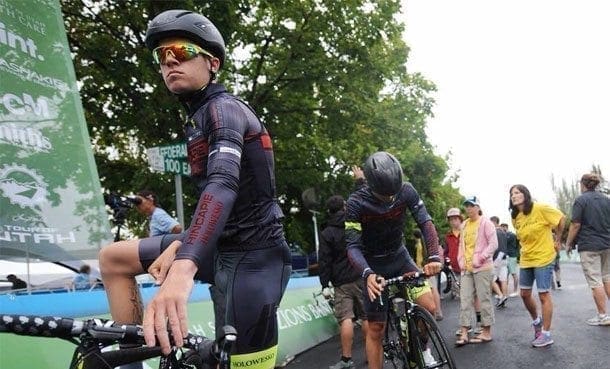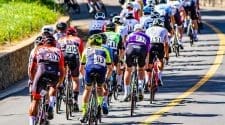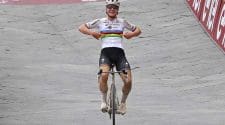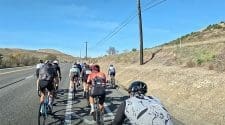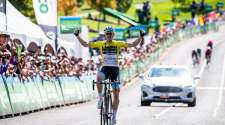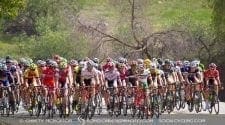Detailed race routes and stage maps were unveiled today for all seven days of the 2016 Larry H. Miller Tour of Utah men’s professional cycling stage race, August 1-7. The 704-mile course will include 52,951 vertical feet of climbing for 16 of the best men’s cycling teams in the world, solidifying the event as “America’s Toughest Stage RaceTM”. The race will pass adjacent to or through two national parks, two national monuments, four national forests and two state parks, with the overall start at Zion Canyon Village in southern Utah and the overall finish in Park City to the north.
The Tour of Utah course will feature more than 700 miles of racing for the third time in its 12-year history. A 2.HC-rated stage race sanctioned by the Union Cycliste Internationale (UCI), the Tour of Utah will give promi- nence to a total of 13 Utah Office of Tourism King of the Mountain climbs and 14 Utah Sports Commission Sprint lines. Detailed maps and videos for race week are now available at the official web site, www.tourofutah.com.
Returning to the Tour for the first time since 2013 is the Stage 3 summit of Mount Nebo, the highest mountain in the Wasatch Range at 11,928 feet. Two of the historically toughest climbs of the Tour are back, classified as hors category (HC, or beyond classification) — the six-mile ascent of Little Cottonwood Canyon on the Stage 6 “Queen” Stage and the epic seven-mile incline to Empire Pass, with pitches reaching more than 20 percent.
“Now in the 12th year of racing, the Tour of Utah has established itself as one of the most awe-inspiring, rolling postcards in North America for a professional sporting event. From the iconic red rock scenery and lush national forests, Utah’s spectacular and diverse scenery will shine on the world stage with the sport’s best riders, many of them coming from the Tour de France. The opportunity to bring high-caliber racing to our fans and partners here in the United States is tremendous,” said Jenn Andrs, executive director of the Tour of Utah.
2016 Larry H. Miller Tour of Utah Route Highlights
• 704 miles/ 1,133 kilometers • 52,951 feet/16,139 meters of elevation gain • 13 KOM climbs • 14 Sprint lines • Third time race has started in southern Utah •Seven road stages over seven days • Seven ski resorts along route
A total of 13 venues are hosting the Tour this year, the highest number of host communities since 2014, when the Tour expanded from six to seven days of racing. Three venues are hosting the Tour for the first time — Escalante, Kearns and Zion Canyon Village. Park City and Snowbird Ski and Summer Resort have the longest tenures as host venues, having served for eight and nine consecutive years, respectively. Cedar City will serve as race headquarters for overall start festivities, including the Team Presentation on Saturday, July 30, which is free for spectators. The additional host venues are Antelope Island State Park, Bountiful, Cedar City, IM Flash (Lehi), Payson, Richfield, Snowbasin Resort, and Torrey.
Stage 1 presented by Workers Compensation Fund begins Monday, Aug. 1, at Zion Canyon Village, the southernmost point in Utah of the event’s 12-year history. The opening 84-mile (135 km) leg begins in the shadows of the jagged spires of The Watchman, one of the most prominent peaks in Zion National Park. As this year’s Tour coincides with the National Park Service Centennial, a once-in-a-lifetime opportunity exists to promote the Centennial goal of connecting with and creating the next generation of park visitors, supporters, and advocates. Through the park, cyclists will proceed as a neutral ride following a pace car, as a cycling demonstration to highlight alternative, non-motorized ways to enjoy the park and to promote exercise and outdoor recreation. Racing will begin after teams exit the East Entrance to the park. The serpentine route passes lava fields and alpine forests of the Dixie National Forest, cresting at 9,600 feet above sea level near Cedar Breaks National Monument. There are two KOM climbs on the stage, and Orderville will host a new Utah Sports Commission Sprint line. The racers will make a 20-mile descent to Cedar City, which last hosted the Tour in 2013 and 2014. Spectators will enjoy three downtown circuits, 2.5 miles each lap, with the finish on the campus of Southern Utah University.
Stage 2 finds familiar territory on Tuesday, Aug. 2, along Scenic Byway 12, an All-American Road that weaves its way through picturesque Garfield and Wayne counties. A new start this year will be hosted in Escalante, famous for its slot canyons and close proximity to Grand Staircase-Escalante National Monument, the nation’s largest national monument. Escalante, which has seen the race pass through in 2013 and 2014, sets the stage for 99 miles (159.3 km) of racing. The peloton will gain 9,435 vertical feet on the day, including KOM climbs of Hogsback and Boulder Mountain. A sweeping descent will be made into Torrey, which hosts the Tour for a third time. New this year will be the addition of two 17-mile circuits after the race reaches Torrey. The circuits undulate around Wayne County and the town of Teasdale, under the shadow of the red spires of Capitol Reef National Park. Sprint lines will be held in Boulder and Torrey.
Stage 3 on Wednesday, Aug. 3, transitions from the red rock panoramas of southern Utah to the Wasatch Mountains of the northern region for the longest stage of the week. Richfield, the seat of Sevier County, is the start for this 119-mile (191.5 km) road race. The first two-thirds of the route take the riders north through the rural communities of Sevier, Sanpete and Juab counties, with Sprint lines in Manti and Fountain Green. Then the riders will crest Mount Nebo, its peak sitting at 11,928 as the southernmost and highest mountain in the Wasatch Range of Utah. The cyclists will summit the roadway at 9,300 feet for the one KOM on the day, then have a twisting and exhilarating 22-mile descent into the classic western town of Payson.
Stage 4 presented by UnitedHealthcare will find the race returning to Salt Lake County for a 10th time in 12 years. On Thursday, Aug. 4, the race will start on the corporate campus of IM Flash in Lehi. The 96-mile (154.4 km) route looks flat on paper, but will traverse a 28-mile stretch of the Mountain View Corridor (MVC) in the foothills of the Oquirrh Mountains. The racers will complete two and a half laps of the MVC freeway for two Sprint line prizes and a total of 70 miles, then drop into the township of Kearns for the first time. There will be three challenging laps of a four-mile circuit that finishes adjacent to the Utah Olympic Oval, site of the long track speed skating events for the 2002 Olympic Winter Games. This five-acre facility is known as the “Fastest Ice on Earth” and is the home to more than 100 world records in speed skating.
Friday, Aug. 5, features Stage 5 presented by Zions Bank, with 114 miles (183.4 km) from Antelope Island State Park to Bountiful. It is a repeat road race from 2015, with short, but very steep climbs and four KOMs — the North Ogden Divide, Trappers Loop and the two ascents of the Bountiful Bench. The start at Antelope Island State Park, which sits on the largest island in the Great Salt Lake, will begin with two three-mile circuits on the island before crossing the seven-mile causeway to the mainland. The race will climb North Ogden Divide, circle Pineview Reservoir, then climb Trappers Loop before re-entering Davis County. Sprint lines will be staged at Hooper, Eden and Bountiful. The two nine-mile circuits in Bountiful return this year, which include a difficult climb on 400 North along the Bountiful Bench. Festivities in downtown Bountiful will be on Main Street at Center Street for the finish, with the peloton rolling in a northbound direction.
Saturday, Aug. 6, is the “Queen Stage” of the Tour of Utah, Stage 6 presented by University of Utah Health Care. This year’s route harkens back to 2013, with the race beginning at Snowbasin Resort, northeast of Ogden in Weber County. After covering 114 miles (183.4 km) and 11,165 feet of climbing, the race will finish at Snowbird Ski and Summer Resort for a record ninth consecutive year. Stage 6 will cross five counties and pass six ski resorts. From the Snowbasin Resort, the course rolls through scenic ranch land in the Morgan Valley and through Brown’s Canyon, with Sprint lines in Wanship and Park City. The showdown for the true climbers begins with an 11-percent gradient, Category 1 climb across Guardsman Pass, followed by a 14-mile descent through Big Cottonwood Canyon. The race concludes with the final legendary six-mile HC climb of Little Cottonwood Canyon, past the throngs of fans at Tanners Flat, for the finish at Snowbird Ski and Summer Resort.
Stage 7 presented by Utah Sports Commission uses the same course that became a classic in 2013, with Park City hosting the Tour for an eighth time. The Sunday finale on Aug. 7 covers 78 miles (125.5 km) with a new start and finish on Upper Main Street in Park City. Spectators can see a flash of the peloton in Kamas and Midway for Sprint lines. Stage 7 has 7,883 feet of climbing, including one of the toughest climbs in the world at Empire Pass, the KOM of the race. This six-mile section of rough pavement through the Aspen trees has a gradient that averages 10 percent, with pitches greater than 20 percent. At the bottom of the technical descent into Park City, where the speed of the racers can exceed 60 miles per hour, the route provides a new finish. A quick lap using Main Street, 9th Street, Park Avenue and Heber Avenue in downtown Park City will provide a final grinding climb to the top of Main Street.
The Larry H. Miller Tour of Utah gained international accreditation in 2011 when it was first sanctioned by the UCI, the global governing body of the sport of cycling. In 2015 the race was elevated to the 2.HC ranking, one of only two such multi-day events in North America. This year’s Tour of Utah will continue as the first internationally-sanctioned cycling competition in North America for men following the Tour de France.
The Larry H. Miller Tour of Utah continues to be free to all spectators, making professional cycling one of the most unique professional sports in the world today. More information about the Tour of Utah and the host venues can be found by visiting www.tourofutah.com, as well as social channels Facebook (tourofutah), Twitter (tourofutah, #TOU16), Instagram (thetourofutah) and YouTube (tourofutah).
Be sure to check out SoCalCycling.com’s Event Calendars for upcoming Road Events, Mountain Bike Events and Fun Rides throughout the season for great cycling events.
No products found.



